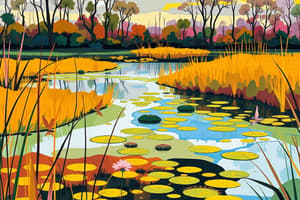Podcast
Questions and Answers
Which type of wetland is characterized by the accumulation of partially decomposed plant remains called peat?
Which type of wetland is characterized by the accumulation of partially decomposed plant remains called peat?
- Coastal Wetlands
- Maritime Mesic Swamps
- Freshwater Wetlands
- Peatlands (correct)
What is one of the key functions of wetlands in terms of water?
What is one of the key functions of wetlands in terms of water?
- Drying up water sources
- Polluting water bodies
- Reducing water quality
- Acting as natural filters (correct)
Where are Mediterranean Salt Marshes typically found?
Where are Mediterranean Salt Marshes typically found?
- Areas with regular precipitation
- Coastal regions with Mediterranean climates (correct)
- Inland regions
- Tropical rainforests
Which type of wetland is influenced by both fresh and saltwater?
Which type of wetland is influenced by both fresh and saltwater?
Wetlands provide habitats for which of the following?
Wetlands provide habitats for which of the following?
What is the major greenhouse gas that can be emitted from wetlands during decomposition processes?
What is the major greenhouse gas that can be emitted from wetlands during decomposition processes?
What is one of the functions of wetlands mentioned in the text?
What is one of the functions of wetlands mentioned in the text?
Why are wetlands considered biodiversity hotspots?
Why are wetlands considered biodiversity hotspots?
What is a way in which wetlands contribute to global cycles?
What is a way in which wetlands contribute to global cycles?
Why are wetlands important for ecosystem resilience?
Why are wetlands important for ecosystem resilience?
What is one negative consequence of wetlands mentioned in the text?
What is one negative consequence of wetlands mentioned in the text?
Which statement accurately reflects the function of wetlands?
Which statement accurately reflects the function of wetlands?
Flashcards are hidden until you start studying
Study Notes
Wetlands: Their Types, Functions, and Importance
Types of Wetlands
Wetlands are transitional zones between land and water, characterized by the presence of water saturation or standing water on the soil surface for varying durations throughout the year. There are different types of wetlands, including:
- Coastal Wetlands: Found in coastal environments, these wetlands are influenced by both fresh and saltwater. Examples include salt marshes, mangroves, and tidal mudflats.
- Freshwater Wetlands: Located inland, these wetlands contain pure freshwater. Examples include swamps, marshes, and bayous.
- Peatlands: Also known as swamps, peatlands are found in areas of low-oxygen conditions, leading to the accumulation of partially decomposed plant remains called peat.
- Maritime Mesic Swamps: These wetlands receive regular precipitation and have a mixture of deciduous and evergreen trees.
- Mediterranean Salt Marshes: Found in coastal regions with Mediterranean climates, these wetlands are influenced by both tides and evaporation.
Functions of Wetlands
Wetlands perform several essential functions:
- Water Quality Improvement: Wetlands act as natural filters, absorbing pollutants from runoff and purifying water before it enters rivers or lakes.
- Fish and Wildlife Habitat: Wetlands provide habitats for numerous species of fish, shellfish, birds, mammals, and other wildlife.
- Flood Protection: Wetlands act as natural buffers against floodwaters, slowing down and reducing the impact of storm surges.
- Carbon Storage: Wetlands are significant carbon sinks, storing more carbon than forests and playing a crucial role in mitigating climate change.
- Recreation and Aesthetic Appreciation: Wetlands offer opportunities for outdoor activities like fishing, birdwatching, and nature photography.
Importance of Wetlands for Ecosystems
Wetlands play a vital role in maintaining ecosystem health and stability:
- Biodiversity Hotspots: Wetlands support high levels of biodiversity, both above and below ground, making them ecologically important.
- Food Webs: The complex relationships between organisms within wetland ecosystems form intricate food webs that sustain diverse life forms.
- Global Cycles: Wetlands contribute to global cycles by facilitating the movement and availability of essential elements like nitrogen, sulfur, and water.
- Ecosystem Resilience: Wetlands help protect against climate change impacts such as sea level rise and extreme weather events.
Methane Considerations
While wetlands serve as vital carbon sinks, they can also contribute to methane emissions due to the decomposition of organic matter under low oxygen conditions. However, these emissions represent a small fraction of global methane sources and are essential for maintaining the overall functioning of wetland ecosystems.
Studying That Suits You
Use AI to generate personalized quizzes and flashcards to suit your learning preferences.




